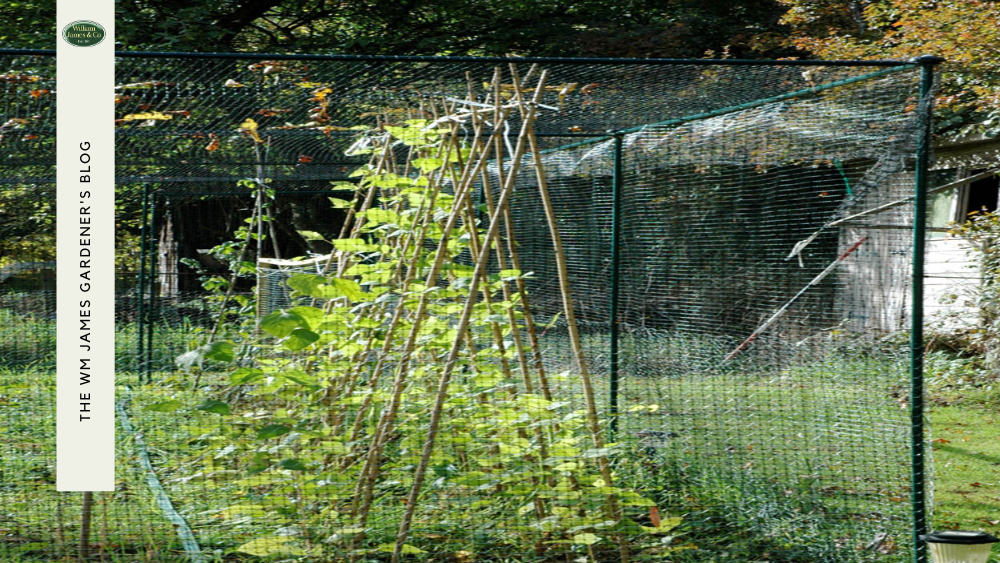We use cookies to make your experience better. To comply with the new e-Privacy directive, we need to ask for your consent to set the cookies. Learn more.
How To Grow Strawberry Plants In The UK
- Admin
- WM James Gardening Blog
- 1 May 2021
-
15views

If you're looking for a guide to growing strawberries in the UK you're in the right place. Luckily, strawberry plants grow really well in the UK - you just need to know what strawberry plant varieties grow best here and how to look after them.
All types of strawberries have their own unique qualities so it's worth knowing what type of berries your plants are going to grow best. There are three main types of strawberries that can be grown in the UK - alpine, woodland and what we're interested in here, everbearing strawberry plants.
Whether you are growing strawberries in your allotment or starting a window box garden at home our guide covers the top strawberry growing questions you need to know!
How To Find The Right Strawberry Plants
Trying to find the right strawberry plants? It is essential to make sure you get good strawberry plants, to begin with, or they will always struggle.
Out top tip is not to be tempted by the cut-price, brown looking specimens you often find in the garden section of DIY stores - go to a proper garden centre, or better still find your local nursery. They are generally cheaper anyway and will know their stuff so you can get handy tips from them (plus you'll be helping support a local business).
In general, you need a tall-growing type - this will give you the maximum fruit. There are three main types of strawberry plants: low-growing alpine strawberries which produce small red fruits for eating fresh; everbearing varieties that yield well in early summer then again later on with a bigger crop; and June-bearing types, which produce a big main summer harvest.
Everbearers are probably most suited to UK conditions as they don't need such high levels of winter chill (the cold weather needed for fruit buds to develop). However, the best advice is always to go with what you know - speak to your supplier and ask what they would recommend for your area.
What Are Daughter Strawberry Plants?
One thing to watch out for is what the supplier calls 'daughter' plants - these are runners that have already produced fruit and will root wherever they touch soil, so you can then pop in the ground elsewhere (you may be charged a small fee for this). It's usually worth buying daughter plants as it means you can get growing straight away, but you'll find it easier to manage your crop if they're all the same variety.
So what should you look for? The runners and daughter plants will be supplied in modules containing at least three or four crowns (the part that eventually produces fruit). They should have a healthy covering of green leaves and not look too dried out. If the modules are starting to open up, ask for a new batch - what you don't want is any chance of disease being passed on.
Make sure they have developed lots of roots so push your finger into the compost and feel around inside. The best ones will be dark brown in colour with masses of fine white root hairs.
You can plant these straight into your growing boxes, or if you're buying in bulk, they'll usually come with their roots wrapped up in what looks like a piece of old tights. If the modules are starting to open at all make sure you put them somewhere cool and dark for 24 hours before planting so as not to shock the roots.

How To Prepare The Ground For Strawberries
Preparing the ground for planting strawberries requires a well dug over and weeded plot, free from any perennial weeds. If you're planting in a new area of the garden where nothing has been grown before then it's important to remove all perennial weed seeds (they'll still be lurking in the ground) and ensure you get down to bare earth - if there are too many weeds, it can stop nutrients getting through.
Make sure the soil is well dug over before planting as strawberries like a rich loamy soil with plenty of organic matter included (compost works very well). If your existing garden has poor or compacted soil you can dig in plenty of well-rotted manure or garden compost, but make sure it's not too rich as this makes for soft fruits with no flavour - what you want are strong tasting berries.
As far as the rest is concerned, your strawberries will benefit from a dressing of bone meal (which gives them extra phosphate to help with flowering) and fish, blood or hoof (for nitrogen).
It all sounds like a lot of hard work but if you've never grown strawberries before it's certainly worth the effort - what could be better than tucking into your own home-grown berries?
When To Plant Strawberry Plants?
In order to get the best crops from your strawberry plants, it is important to plant them at the right time of year. If you want a big summer crop, then planting in spring gives them more time for growth before they have to produce their fruit - what you don't want to do is rush into things and end up with small berries that will soon be overtaken by weeds.
Strawberry plants are what is known as 'short day' crops, which means they flower and fruit on the current season's growth - so the longer you leave them in place, the more chance they have of producing a bigger crop. Ideally, this would mean planting your new strawberry runners or daughter plants at the end of January or early February.
You can get an idea of what sort of crop you'll be getting by looking at the size and number of flowers on the plant - if they're big, round and white then it will give a good yield!
I normally plant in the spring but you can get away with planting as late as September. If you're just planting in a pot or grow bag, what I do is to put the strawberry plant into its final position and then cut off all but about an inch of foliage from around the crown.
How To Plant Strawberry Plants
The planting of strawberry plants is what's known as 'bare rooted' and it means that you can plant them straight into their final position, without having to pot them on first. If you're growing in a border or raised bed, I would advise digging over the area well so there are no perennial weeds lurking underneath.
Some people plant them through a layer of a weed-suppressing membrane which seems to work really well but I use purpose-built strawberry planters to save space.
It's also a good idea to put some type of support in place as soon as you plant. Support doesn't have to be elaborate either; what I do is take four stakes with notches at the top and bind them together with garden twine, which will support your strawberry plants throughout their lives.
When it comes to planting strawberries dig a hole that's deep enough to accommodate what's left of the root ball (don't forget it will have grown considerably by this point) and make sure the crown is just at soil level.
Fill up with earth and firm down gently, making sure there are no air pockets - what you want to achieve here is a nice tilth (if it's too wet keep on digging). Water in well then leave for about ten days before planting out into its final position or potting onto into a grow bag.
If you're planting into the ground, what I would do is plant your runners in pots of compost and leave them to establish for around four weeks before transplanting when they are about 15cms high - this will help harden them off ready for their new home.
What you want to do now is protect your new planting from hungry birds by covering it with some fine shade netting or horticultural fleece until they are established - this may take a few weeks.

How To Grow Strawberries In Containers?
If you don't have a garden or the space to plant in, what about growing your own strawberries on the patio instead? If they get enough sunshine and warmth (soil temperature should be at least 18C) then it's certainly possible - what you need is some good quality, free-draining potting compost and a large container - what I do is use old plastic dustbins.
Make sure they have drainage holes in the bottom before you fill them with compost, put your strawberry plants into the soil (or buy some seedlings from a garden centre) water well, cover with netting or fleece to keep off the birds, move them into the sunniest spot you've got and enjoy your lovely home-grown strawberries!
How To Grow Strawberries On A Patio?
The same rules apply - water well during dry spells (especially once they start fruiting), keep weeded out what weeds there are in pots or you'll get pest build-up and don't forget to feed them! You can buy a fertilizer designed for strawberries from the garden centre.
It's not uncommon that you'll get what is known as 'replant disorder' where your strawberry plants stop fruiting after a couple of years but again, it's easy enough to keep on top of - just replace with new plants.
General Tips For Growing Strawberry Plants
If you're feeling brave, you can grow your own plants from runners - just find a friend or neighbour with some healthy-looking plants and look for runners growing out of the side (they start off as a tendril or stalk which grows out from the base).
When it gets to a certain length your strawberry plant will sprout a set of leaves and start to grow its own roots from the bottom. Carefully snip the runner away from the main plant, trim off the rest of the stalk and put it into a pot of compost, making sure that the 'crown' (the top of the brown bit the leaves sprout from) is just at the surface of the soil.
Make sure it's well watered and put it in a warm, frost-free place - I leave them outside as I think it makes them hardier. Not all runners will take, so do more than you need, but I get a pretty good success rate and they are free after all!
You don't have to plant strawberries in a fruit cage, but it's probably the best option. Fruit cages are also great for other fruits and vegetables too - tomatoes, peppers etc. so you're not limited to what you can grow.
If you're growing them on your allotment, what you do is up to you! Just make sure they are secure - netting or wire can be used.
How To Care For Strawberry Plants
Make sure you water your strawberry plants well during spring and summer (especially if it's hot) and keep them well weeded. They will benefit from being fed - a seaweed or other liquid fertilizer is fine but don't feed them while they're fruiting.
While they fruit, you need to keep the strawberries dry and off the ground to stop them rotting - you can use a handful of straw or a 'strawberry mat' for this.
The birds will try to eat the strawberries before you can get to them so make sure you net them off and get something rigged up to scare them away (a plastic bottle on the end of a cane works quite well) or a fruit cage is perfect for the job.
Good luck!













